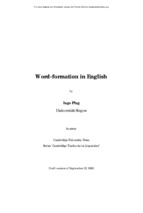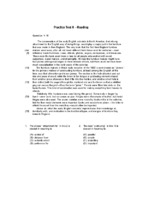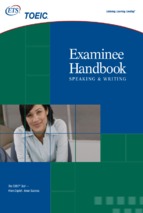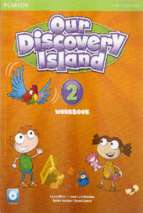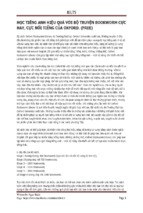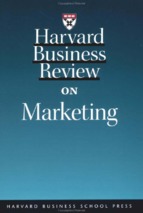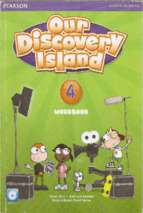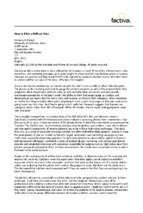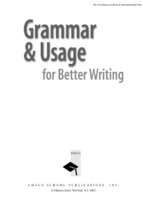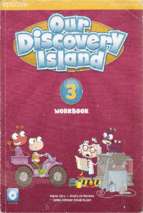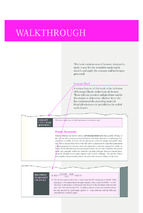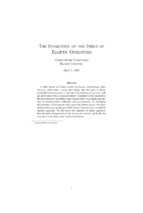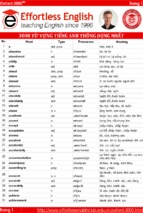penguin reference
T H E P E N G U I N D I C T I O N A RY O F
AMERICAN ENGLISH USAGE AND STYLE
Paul W. Lovinger was a staff reporter and columnist for
newspapers for two decades. His freelance writings include
The Marijuana Question (with Helen C. Jones), a widely acclaimed study of the drug as viewed by scientists and users.
He also writes songs, both music and lyrics (specializing in
children’s and novelty). He lives in San Francisco.
t h e P E N G U I N D I C T I O N A RY o f
AMERICAN
ENGLISH USAGE
AND STYLE
���
A Readable Reference Book,
Illuminating Thousands of Traps
���
That Snare Writers and Speakers
pau l w. l ov i n g e r
p
penguin reference
PENGUIN REFERENCE
Published by the Penguin Group,
Penguin Putnam Inc., 375 Hudson Street, New York, New York 10014, U.S.A.
Penguin Books Ltd, 27 Wrights Lane, London W8 5TZ, England
Penguin Books Australia Ltd, Ringwood, Victoria, Australia
Penguin Books Canada Ltd, 10 Alcorn Avenue, Toronto, Ontario, Canada M4V 3B2
Penguin Books (N.Z.) Ltd, 182-190 Wairau Road, Auckland 10, New Zealand
Penguin Books Ltd, Registered Offices:
Harmondsworth, Middlesex, England
First published in the United States of America by Penguin Reference,
a member of Penguin Putnam Inc., 2000
This eBook edition published in 2002
Copyright © Paul W. Lovinger, 2000
All rights reserved.
Lovinger, Paul W.
The Penguin dictionary of American English usage and style : a readable reference book,
illuminating thousands of traps that snare writers and speakers/ by Paul W. Lovinger.
p. cm.
ISBN 0 7865 2886 9
Set in Minion with Schneidler Initials
Designed by Betty Lew
Map and endpapers by Mark Stein Studios
Making or distributing electronic copies of this book constitutes copyright infringement
and could subject the infringer to criminal and civil liability.
First edition (electronic): November 2002
contents
i n t ro du c t i o n : wat c h i n g o u r wo r d s
vii
g e n e r a l to p i c s
xiii
l e x i c o n , a to z
1
r e f e r e n c e wo r k s
487
i n t ro du c t i o n
Watching Our Words
Aim; Form
The volume in your hands is meant to
be both useful and enjoyable, a readable
dictionary for all who are interested in
our language.
In A-to-Z form, it is mainly a guide to
good usage of English, the American
variety, contrasted with some 2,000
quoted examples of misusage and questionable usage. It does the job of “illuminating many traps and pitfalls in English
usage” (as my editor puts it). I have
sought to provide clear explanations in
plain language. This book is designed for
general readers as well as those who
work with words.
The examples were drawn from the
popular press, broadcasting, books, and
a variety of other sources, mostly in the
latter eighties and the nineties. Each
entry devoted to a specific word or
phrase contains one or more of those
quotations. The troublesome forms are
contrasted with the proper forms (which
are emphasized by italics) and definitions are given.
Entries on general topics are presented too; they deal with matters of
grammar, punctuation, style, and so on.
A list of them, with further description
of the two types of entry, appears under
“General Topics,” following this introduction.
With few exceptions, the examples
have determined the choices of word
entries. Thus the book in part amounts
to an informal survey of contemporary
problems in English usage.
Both perennial problems and new
ones come up. Of the misuses discouraged by earlier books on English usage,
some persist; others have not turned up,
but, as though to take their place, new
offenses against the language have
emerged.
Here are some hints for finding your way
around the volume:
• Main entries, headed in boldface,
are arranged alphabetically, letter by
letter.
• Many entries are divided into
sections, which are numbered and
titled. The sections of an entry are
arranged alphabetically, and their
titles are listed at the beginning,
after the main title. Some sections
contain subsections, distinguished
by letters and titles.
• There are numerous crossreferences, some standing alone and
others within entries. For instance,
in the C’s under Comma it says See
Punctuation, 3, referring the reader
to the entry. Many entries refer to
related entries. Alphabetical order
is used in listing any series of crossreferences and various other
series.
last entry
vii
viii
introduction
Viewpoint
This work could be viewed as an antidote to laissez-faire lexicography and
anything-goes grammar. The doctrine
that whatever emerges from people’s lips
is the language and that many verbal
wrongs make a right is not advocated
here. Nor is the cliché of English as “a
living language” dragged in to justify
bad English.
On the contrary, I do not hesitate to
distinguish between right and wrong
usage when the difference is clear. My
inclination is to question deviant forms,
challenge innovations to prove themselves, and resist senseless fads. (See also
the final section of this introduction.) I
thereby risk being labeled a “purist” by
some critics—as though impurity were
desirable.
Perhaps in a long-range, philosophical sense there is no verbal right and
wrong. But that view does not help you
and me in choosing our words and
putting together our sentences clearly
and properly according to the educated
norms of society. Those holding the permissive views follow most of the norms
themselves. They do not say or write,
“Them guys hasn’t came,” or “I ain’t did
nothin nohow,” although some people
are apt to do so. For the most part, the
laws of grammar have not been repealed.
Not that one should be pedantic
either. The book does not flatly condemn
split infinitives, prepositions at the end
of sentences, conjunctions at the beginning, sentence fragments, or phrases like
“It’s me.” But it does value precision
over fashion, logic over illogic, and
grammatical correctness over “political
correctness.” (In my view, those who
mutilate our language for political
motives do wrong.)
At times the difference between correct and incorrect usage is hazy. English
has an abundance of words,* more than
any other language, and multiple ways
to express almost any idea. Our language is so complex that nobody ever
learns it all and that even its leading
authorities occasionally stumble. They
disagree and one finds fault with another. Their differences concern both
specific points and standards of strictness or looseness in the use of words and
grammar.
Some loose uses of words or phrases
and some slang that may pass harmlessly
in informal conversation are inappropriate when transferred to serious writing
or even serious speech. This book will
help the reader to make sound choices.
Examples
Samples of sentences that clearly fall
into the wrong category follow. The first
few are (alternately) by professionals of
broadcasting and journalism. A correction follows each quotation. (Each
comes up in the main text.)
“There were roofs completely tore
up.” Torn up.
“I like to serve it with croutons . . .
that is flavored with olive oil.” Are flavored.
“Police said ——— and ——— built
the bombs theirselves.” Themselves.
“It would be more racism showing it’s
ugly head again.” Its.
“There is a way to empower your
*The Oxford English Dictionary, seeking to record all English words, says it covers more
than 500,000 words and phrases in its twenty volumes. The Guinness Book of World
Records places the count at more than 600,000 words plus 400,000 technical terms, a total
exceeding a million. It numbers the Shakespearean vocabulary at 33,000 words and expresses
doubt that any person uses more than 60,000.
introduction
children and make them far more better . . . students.” Delete “more.”
“Women have smaller brains then
men.” Than.
“The . . . campaign has got to break
into the double digits to be respectful.”
Respectable.
(Headline:) “Be Happy She Prys.”
Pries.
Additional slip-ups, by people in other
fields, include these:
(Advertising:) “I always wanted to
loose weight.” Lose.
(Book publishing:) “Allow someone
else to proofread [edit?] it . . . who will
not be affraid to be biased in their opinion.” Afraid to be unbiased in his opinion.
(Diplomacy:) “It is quite clear that the
crisis has reached a critical point.”
Better: the dispute or the situation.
(Education:) “Me and my kids live in
a dormitory.” I and.
(Law:) “No one is free to flaunt the
tax laws.” Flout.
(Medicine:) “We’re obligated to do
that biopsy irregardless of the physical
findings.” Regardless.
(Psychology:) “Their child don’t look
so good.” Doesn’t look.
The book debunks some widespread
misbeliefs. If we do not fully understand
ix
the meanings of certain words or if we
accept some clichés on their faces, we
may believe that fury rages in the “eye”
of a storm; a “fraction” is a small part;
the character “Frankenstein” was a
monster; to “impeach” an official is to
oust him from office; a jury can find a
defendant “innocent”; pencils contain
the metal “lead”; a “misdemeanor” is
not a crime; prostitution is the “oldest
profession”; an exception “proves” a
rule; the Constitution guarantees “the
pursuit of happiness”; and so on.
The criticism of any extract does not
negate the overall merit of the work that
is quoted.*
Clarity
Clarity is a leading theme of this
book. More than 100 entries deal with
the problem of ambiguity (noun): the
state of being ambiguous (adjective),
able to be interpreted in two or more different ways. Consider this sentence:
“When P—— was hired by H——, he
had a criminal record.” Which one is
“he”? (That example is from Pronouns,
1. Consult also the cross-reference
Ambiguity and the next section of this
introduction, Wounded Words. General
examples of fuzzy prose appear in
Verbosity and other entries.)
Clear expression requires clear think-
*Of 2,000-odd examples of misusage or questionable usage, almost half originated with
newspapers, news agencies, or magazines; about a fifth each with broadcasters and books;
and a tenth with people in many other fields or miscellaneous sources, described in the text.
A few appeared in other reference works.
The single most frequent source of examples was The New York Times (usually the
national edition), which occasionally is quoted here approvingly too. Newspapers distributed
in the San Francisco Bay area and TV and radio broadcasts heard there were significant
sources. Dozens of other newspapers, from most regions of the country, yielded examples too.
So did 120 books, mostly nonfiction. Some correct or incorrect examples, not counted above,
were composed where fitting.
The sources of the quotations are not usually identified by name. Space did not permit the
publication of a list of such sources (although it had been contemplated). But a variety of reference works consulted as sources of information are listed in the back of the book.
x
introduction
ing. It helps also to be versed in the distinctions among words and in the elements of grammar, including tense,
number, mood, parts of speech, sentence
structure, and punctuation. Even so,
clarity may not survive hastiness, inability to express ideas simply, intentional
hedging, lack of facts, language that is
too pompous or too slangy, obscurity of
ideas or terms, overloading of sentences,
overlooking of double meanings, stinginess in using words or punctuation, too
little thought, or too much abstraction
and generality without concrete examples.
Then, too, muddiness and confusion
can overcome our best efforts. Writers
on the English language often compare it
with other languages and glory in its
complexity, variety, and subtlety. Yet the
language is so complex, with varieties of
expression so vast, subtleties so fine, and
such a proliferation of word meanings,
that it can trap any of us at some time or
other. Unqualified praise helps no one.
Let us be aware of the difficulties and try
to overcome them.
Greater efforts to write and speak
clearly, accurately, and sensibly would
mean more understanding, something
that society needs.
Wounded Words
One of the problems is that English is
being deprived of the benefit of many
distinctive words as looser meanings
develop. The addition of the new meanings renders some of the words ambiguous. I call them wounded words.
Examples of those words and their
strict meanings follow; loose meanings
are in parentheses. Which meaning a
writer or speaker has intended is not
always plain from the context.
A fabulous story is one that is characteristic of a fable (or a good story). An
impact is a violent contact (or an effect).
A legendary figure is mythical (or
famous). One who is masterful is dictatorial (or skillful). To scan a document is
to examine it carefully and systematically (or quickly and superficially). If a
scene is a shambles, it shows evidence of
bloodshed (or disorder). If an incident
transpired this year, this year is when it
became known (or happened). When an
ultimatum is given, a threat of war is
issued (or a demand is made). That
which is viable is able to live (or feasible).*
Many loose or questionable uses are
widespread. Does that mean we have to
follow suit? Of course not.
Save the Language
New words continually appear. Those
that fill needs are generally desirable.
What ought to be questioned or resisted
are the watering-down of distinctive
words that we already have, the creation
of ambiguity and fuzziness, the breakdown of grace and grammar, and irrational verbal fads.
Change characterizes the history of
English; but whereas innovations in the
main language used to be tested slowly
by time, and street slang usually stayed
there, they are now both thrust upon the
public almost instantly by the media of
mass communication.
*Among words in similar condition are these: accost, alibi, anticipate, bemuse, brandish, brutalize, burgeon, careen, classic, cohort, compendium, connive, cool, culminate, decimate, desecrate, destiny, dilemma, disaster, effete, eke, endemic, enormity, erstwhile, exotic, fantastic,
formidable, fortuitous, fraction, gay, idyllic, incredible, increment, internecine, jurist, literal,
livid, marginal, mean (noun), minimize, neat, obscene, outrageous, paranoid, pristine, quite,
sure, travesty, unique, utilize, verbal, virtual, vital, weird, wherefore, willy-nilly. The words
emphasized in this section have separate entries.
introduction
Our language is an invaluable
resource, as much a part of our heritage
as forests, wildlife, and waters. Yet
where are movements for verbal conservation? Who campaigns to save endangered words? When do we ever see
demonstrations against linguistic pollution?
xi
To support the cause of good English,
you and I need not join a group, attend
rallies, or give money. We can contribute
every day by knowing the language,
shunning the fads, and watching our
words.
P.W.L.
San Francisco
g e n e r a l to p i c s
Here is a list of the titles, or headings, of this book’s main topic entries—that is,
entries that deal with general topics.
They are distinguished from word entries—which discuss how to use the particular words in their titles. (Those entries are not listed.)*
Following this list comes a list of cross-reference titles on general topics.
Abbreviation
Active voice and passive voice
Adjectives and adverbs
Anachronism
BACK(-) prefix and pairs
Backward writing
BI- and SEMI- prefixes
Capitalization
CIRCUM- prefix
Clause
Cliché clash
Clichés
Collective nouns
Comparative and superlative degrees
Comparison
Complement
Confusing pairs
Contractions
Crimes (various felonies)
Dehumanization
Division of words
Double meaning
Double negative
Double possessive
Ellipsis
Expletives
FACT- words
Gerund
Guilt and innocence
Hawaii
Homophones
I and i
Infinitive
Iran
Italic(s)
-IZE ending
Joining of words
Metaphoric contradiction
Modifiers
Modifying
Mood
NANO- prefix
Nouns
Number (grammatical)
Numbers
Paragraph
*The titles in the two categories differ in their use of capital or lower-case letters:
• The title of a topic entry, such as Punctuation or Verbs, is printed in lower-case letters,
except for an initial capital. (Prefixes and suffixes, in capitals, are a further exception.)
• The title of a word entry, such as AFFECT and EFFECT or COMPRISE, is printed in
capital letters, except for any incidental word, like and.
(In a word entry, the lower-case and indicates a contrast between the main words. A
comma—as in BEMUSE, BEMUSED—separates forms or words in the same category.)
xiii
xiv
general topics
Participle
Personification
Plurals and singulars
Possessive problems
PRE- prefix
Prepositions
Pronouns
Pronouns’ classification
Punctuation
Quotation problems
Range, true and false
Reversal of meaning
Run-on sentence
SELF- prefix
Sentence fragment
Series errors
Spelling
Subjunctive
Synonymic silliness
Tautology
Tense
Titles
Trademarks
Twins
Verbal unmentionables
Verbosity
Verbs
-WISE ending
-Y ending
The following list presents cross-reference titles on general topics. They are found
in their alphabetical places in the text. (Cross-reference titles on specific words are not
listed. Additional cross-references, untitled, may be found within many entries.)
Absolute constructions
Abstract noun
Accuracy and inaccuracy
Accusative case
Adverbs
Agreement in number
“A” instead of personal pronoun
Ambiguity
ANTE- and ANTI- prefixes
Antecedent
Apophasis
Apostrophe
Apposition, appositive
Articles (parts of speech)
Attributive adjective
Auxiliary verbs (helping verbs)
Bible
Brackets
Bullet
Case of letters
Case of pronoun
Colon
Comma
Common nouns
Compounds (words)
Concrete noun
Conditional sentences
Conjunctions
Contrast
Copula or copulative verb (linking
verb)
Correlative conjunctions
Creatures, plural
Danglers
Dash
Dative
Declarative sentence
Defining clause
Digits spelled out
Double entendre
Double genitive
Doubling of letters
-EN, -REN plurals
Enumerations
Exclamation point
-F ending
Figures
Fire
Fractions
-FUL ending
Fused participle
Future tense
Genitive (possessive)
Germanisms
Helping verbs (auxiliary verbs)
Homographs and homonyms
HYPER- and HYPO- prefixes
Hyphen
general topics
-ICS ending
IF clauses
Imperative
Incomplete sentence
Indicative
Inflected and uninflected forms
-ING form of verb
Initials
INTER- and INTRA- prefixes
Interrogative sentence
Intransitive and transitive verbs
Inversions
-ISE ending
Juvenile language
Law, courts, legal terms
Lists
-LY ending
Measures, quantities
Metaphor
Misquotation
Names of products
Names, plural
Negatives
Nominative case
Nondefining clause
Nonrestrictive clause
Object(ive) complement
Object, objective case
-O ending
Pairs of words
Parentheses
Passive voice
Past tense
Per cent, percent
Perfect infinitive
Perfect tenses
Period
Person (grammatical)
Phrase
Positive degree
Predicate
Predicate adjective
Predicate noun (predicate nominative)
Prediction
Prefix
Present tense
Preterit, preterite (past tense)
Probability
Progressive tenses
Proper nouns (names)
Quantities, measures
Question mark
Quotation marks
Reflexive pronouns
Repetition and its avoidance
Restrictive clause
Scientific writing
-SELF, -SELVES endings
SEMI- and BI- prefixes
Semicolon
-S ending
Sequence of events
Shakespeare
Sibilant endings
Singulars and plurals
Slash
Split infinitive
Statistics
Stealing
Subject
Subjective case
Subject(ive) complement
Subject-verb agreement
Substantive
Suffix
Superlative
Time
Transitive and intransitive verbs
Virgule
Voice
Will (legal)
Wit
Words that sound alike
xv
t h e P E N G U I N D I C T I O N A RY o f
AMERICAN
ENGLISH USAGE
AND STYLE
���
A
A and AN. The choice of using a or
an before a word depends on the sound
of the word. Use a if the next word begins with a consonant: a daisy, a good
egg. Use an if the next word begins with
a vowel: an ape, an easy victory.
The wrong choice showed up in three
newspapers. A federal official was
quoted (or misquoted) as saying, “We
are concerned any time there is a allegation of serious wrongdoing. . . .” In another news story, an investor “filed a
$800 million lawsuit.” In a column, a
presidential candidate drove “a M-1
tank.”
Corrections: It is “an allegation,” because allegation begins with a vowel
sound. It is “an $800 million lawsuit,”
because eight begins with a vowel
sound. (The number phrase would be
pronounced as eight-hundred-milliondollar.) And it is “an M-1 tank”: Although m normally is a consonant, the
letter as such is pronounced em.
A precedes the sound of the y consonant, even if the initial letter is usually a
vowel: a European, a ewe, a uniform.
The use of an before such a word is not
standard.
An precedes a word starting with a
silent h: an hour, an honorable man. Using an before a pronounced h, in a word
whose h was once silent, like historic or
humble, is an uncommon practice in the
U.S.A. but more common in Britain. It is
observed by a few American writers and
speakers, such as an anchor woman who
said, “NASA today called off an historic
space mission.”
The foregoing rules assume that one
needs a or an (indefinite article) and not
the (definite article). A or an goes before
a word or phrase denoting a person or
thing (noun) but not a specific one. The
person or thing is usually singular but
sometimes plural: a few good men, a
great many people.
A or an is properly omitted from
some common constructions. One variety contains no followed by an adjective:
“no better time” / “no more beneficial
discovery” / “no such animal.” Another
contains kind, sort, type, species, or the
like: “that kind of gem” / “this sort of
thing” / “some type of evergreen.”
Meaning can hinge on the presence or
absence of a or an. “A novelist and poet
spoke” suggests one person. For two
persons, an extra a is necessary: “A novelist and a poet spoke” (although “both
spoke” makes it clearer). “The zoo will
acquire an apteryx, or kiwi”—two alternative names for the same creature. But
“The zoo will acquire a koala or a wombat”—one or the other.
In writing certain phrases that contain a, particularly a lot and a hold,
some people erroneously affix the a to
the noun. A while may be properly written as one word sometimes, but not al-
a and an
1
2
abbreviation
ways. See A WHILE and AWHILE;
HOLD; LOT.
See also THE.
Abbreviation. 1. Code letters. 2.
Three forms.
1. Code letters
A newspaper article uses the initials
“APS” eleven times but never says what
they stand for. In the same issue, another
article mentions “WIPP” twice without
explaining it. Another newspaper mentions “North Carolina A&T State University” three times in an article, never
informing the readers (mostly nonCarolinians) what “A&T” stands for.
A piece by a news agency cites a
“DOE study done by Aerospace Corp.
of Los Angeles.” The context indicates
that the research did not involve female
deer. But the uninitiated reader has no
way to relate those three letters to “Energy Department,” which is mentioned
several paragraphs before and after
“DOE.”
Unless initials are as widely known as
U.S., C.O.D., M.D., and the letters of
the broadcasting networks, the full name
or phrase should be used at first. If the
initials will be used thereafter, the full
name may be linked to them in this way:
“Albuquerque Public Schools (APS)” or
“Department of Energy (DOE).”
Often initials are unnecessary. In subsequent references it may be clearer to
refer, for example, to the schools or the
department. Better yet, repeat the full
name, if it is not too long.
Even when initials are explained at
the start, they can challenge one’s memory if there are too many of them. A
book on international law contains
statements like this: “. . . The remaining
40 NNNS parties to the NPT had still
not . . . [concluded] a safeguards agreement with the IAEA.” One chapter uses
such forms some 300 times. A reader
needing a reminder has to go back and
hunt for it.
In telling of the bags O. J. Simpson
took to “LAX,” was a television reporter lax in assuming that everyone
knew the airline industry’s code for the
Los Angeles airport? San Francisco
newscasters continually spell out
“SFO,” never identifying it as their airport’s code. It has at least eighteen other
meanings.
One of those newscasters said on the
radio, “There will be no water rationing
this year for East Bay MUD [pronounced “mud”] customers.” Some listeners may have heard of the East Bay
Municipal Utility District. Others may
wonder who would want to buy mud.
2. Three forms
Technically, three main condensed
forms may be distinguished, though all
three are often lumped under the word
abbreviation.
An abbreviation, strictly speaking, is a
short version of a word or phrase in
writing, such as Rep. for Representative
and etc. for et cetera.
An acronym is pronounced like a
word; it is formed from initials or parts
of a name or phrase. Examples are AIDS
from acquired immune deficiency syndrome and LORAN from long-range
(aid to navigation).
An initialism is composed of initials
that are spelled out in pronunciation, letter by letter, such as FBI for Federal Bureau of Investigation and cc for cubic
centimeter(s).
See also Punctuation, 8; and Titles, 2.
ABDOMEN. See STOMACH.
ABIDE and ABIDE BY. To abide
something usually means to endure it, to
tolerate it. “Can you abide such hot
weather?” It can also mean to await it.
A columnist thinks that the press has
treated a certain local politician too
kindly. The politician “has succeeded in
making himself the personification of the
city.” An attack on him therefore be-
accused, alleged, reported, suspected
3
comes an attack on the city “and no one
can abide by that.” It should be “and no
one can abide that.” Omit “by.”
To abide by something is to comply
with it, conform to it. “I abide by the
law.” / “I’m a law-abiding citizen.”
The past tense and past participle of
abide is abode or abided.
Is the reporter so afraid of sticking her
neck out that she requires the weight of
authority behind an announcement of a
holiday?
ABOUT TO. See NOT ABOUT TO.
ACCOST. To accost is to approach
Absolute constructions. See Modifiers, 1D.
Abstract noun. See Nouns, 1.
ACCEPT confused with EXCEPT.
See EXCEPT and EXCEPTING; Homophones.
ACCORDING TO. According to is
a common phrase that is used in sentences like these: “A promising discovery
in the fight against flat feet was made this
week, according to a local professor.” /
“According to the sect, the world will
come to an end next Thursday.”
It tells us that the statement is made
on the authority of the one quoted. It implies that the writer does not vouch for
the veracity or sense of the statement or
may even question it. Thus it should be
used with caution.
News people sometimes append “according to” to what should be matters of
objective fact. For example:
According to the administration,
Contra aid will run out September 30.
Will it or won’t it? If the writer has any
doubt, he should find out for himself.
Some statements are too obvious to
need any attribution, let alone the “according to” form. This item is no scoop:
Many Jewish students at SF State
will not be attending class today due
to Rosh Hashana, the Jewish New
Year, according to A—— S——, Di-
rector of Programs of the Northern
California Hillel Council. [See also
DUE TO.]
and speak to someone first. A panhandler and a person seeking directions accost people on the street. Some have the
mistaken idea that it means to assault or
attack.
A news report on national television
said that several friends were “accosted
by a white mob.” Probably attacked
should have been used instead of “accosted.”
A city official, speaking about assaults
on parking officers, referred to “their
chances of being accosted.” He meant
assaulted.
Accuracy and inaccuracy. See Numbers, 5; Quotation problems, 1; Reversal
of meaning.
Accusative case. See Pronouns, 10 A.
ACCUSED, ALLEGED, REPORTED, SUSPECTED. 1. Accused in the news media. 2. Two
adverbs.
1. Accused in the news media
“An accused mass murderer finally
gets his day in court,” it was announced
on local television. This would have
been a better way to phrase it: “A man
accused of mass murder finally. . . .”
What the newscaster essentially called
him was a mass murderer who had been
accused.
Such misuse of the participle accused
has become fairly common among news
people. They assume that it protects
them from any libel suit. When they describe someone as an “accused thief,”
4
acronym
for example, they mean he is not definitely a thief, just one who has been accused of being a thief. But to call
someone an “accused thief” is still calling him a thief. “Accused” modifies
“thief”; it does not mollify it. Similarly
an “accused doctor” or “accused
lawyer” is a doctor or lawyer who has
been accused.
The misuse of alleged, as a synonym
for “accused” in its objectionable sense,
has long been established among journalists. An example: “Dazed and bleeding from a vicious assault . . . Laurie
M—— pleaded with alleged attacker
David A—— to take her to a hospital. . . .” Alleged normally means declared as such without proof. But the
sentence essentially says the accused man
committed the crime; “alleged” scarcely
mitigates the nastiness joined to his
name. A fairer phrasing would be:
“. . . Laurie . . . pleaded with her attacker—alleged to be David . . . —to
take. . . .”
Suspected is apt to be treated in the
manner of the other two questionable
words. The comments about accused
hold for suspected. A “suspected assailant” is an assailant who is suspected,
according to the literal meaning of the
words. In stating that “serious damage
has been done to national security by
convicted or suspected spies,” two newspaper by-liners show that they regard
“suspected spies” the same as convicted
spies. (See Guilt and innocence, 3.)
The word reported often is used in a
similar grammatical way. Although usually applied to incidents, rather than
people, its presence can raise questions.
For instance, when a news story mentions a “reported crime,” is it referring
to a crime that has been reported to the
police, or is it just using “reported” in its
vague, journalistic sense, as a supposed
hedge against legal action, or as if to say:
“We’re not sure that it happened, but we
were told that it did”?
Writers and editors should be aware
that none of the four words in question
will protect them against suit. It is not
enough to say “There really was an accusation”—or “allegation” or “report”
or “suspicion”—if its substance was
false or erroneous. As a rule of thumb,
avoid charged prose if there is no
charged defendant.
2. Two adverbs
Allegedly and reportedly (a later arrival) occupy the domain of the news
media, and there they should be confined. They are used in this way: “The
accused man allegedly [or “reportedly”]
struck the victim.” In grammatical
terms, the selected adverb modifies the
verb, struck. Someone ought to explain
in what manner the accused person
struck the other when he “allegedly”
struck him or “reportedly” struck him.
During our Persian Gulf war, a banner
in an American newspaper cried: “Hussein reportedly asks for asylum in Algeria” (referring to President Hussein of
Iraq). The “report” came from a French
newspaper, which cited no source. No
more was heard of it. We need not ponder the unimaginable act of “reportedly
asking”; a larger question is involved:
When an editor finds a story so shaky
that he must qualify its headline with
“reportedly,” should he not think twice
before running it at all?
ACRONYM. See Abbreviation.
ACROPHOBIA. See HOMOPHOBIA.
“ACROSS FROM.” These two sentences, which appeared in newspapers in
Texas and New York, raise questions:
“The farm is across from the plant.” /
“. . . This man’s brother was across from
the President’s house with a gun. . . .”
Across what? The tracks? The street?
The park? Use of the slang term “across
active voice and passive voice
from” requires that the topographical
entity in the way be obvious.
5
If you’re in the market for highquality furniture, this sale should not
be missed.
tions:” Five numbered paragraphs follow. Such a format lends itself to the passive.
Too much passive can get dull. Scientists load their writing with it. If you
read research papers, you can get the
idea that scientists never do anything.
Somehow everything is done, as though
by magic. Take the following description
of an experiment, from a biology annual
(emphasis added).
Notice how weak the sentence gets after
the comma. It starts out in the active
voice and finishes in the passive voice. It
would have more punch if it followed
through actively: “. . . don’t miss this
sale” or “you should not miss this sale.”
The inconsistency as much as the relative
weakness of the passive voice impaired
the announcement.
Voice is the form of a verb that indicates whether the subject of a sentence
performs the action or receives the action. The two sentences that follow express the same thought in two ways.
Stock suspension of normal erythrocytes were prepared from freshly
heparinized rat blood. . . . The plasma
and buffy coat were removed, and the
cells were washed. . . . The supernatant of the first washing was
discarded, and the cells were resuspended and diluted. . . . NACl dissolved in 10 ml sodium buffer, at the
appropriate Ph, was chosen for the
preparation of the hypotonic solutions. . . . The required standard 50%
hemolysis was reached by adjustment
of the NACl concentration.
Active voice and passive voice. An
announcer broadcast the following sentence, and in a sense he spoke with two
voices.
• “Matilda found a chinchilla” is in
the active voice. The subject
(Matilda) performed the action.
• “A chinchilla was found by
Matilda” is in the passive voice. The
subject (a chinchilla) received the
action.
The active voice is more direct and
usually more forceful than the passive.
Nevertheless, the passive has a place.
You may want to emphasize the doing
and play down the doer. The identity of
the doer may be obvious, unknown, insignificant, or indefinite: “Letterpress
printing is not used much now.” / “Flags
are being lowered to half-mast.” / “The
package was delivered yesterday.” / “It
just isn’t done.”
A book on world history says, “The
Neolithic stage in culture is characterized by the following important innova-
The combining of voices can produce
a sentence that is not just weak but also
ungrammatical. It happens when a verb
in the active part does not agree with
anything in the passive part. Such a sentence appears in the foreword of a generally admirable dictionary. The sentence
preceding it says the editors do not give
merely the essence of a definition.
Instead, the reader is given the necessary additional connotative information, even if it means devoting a good
deal of space to doing so. . . .
The sentence is passive up to the second
comma; thereafter it is active. That fact
alone does not spoil it. The trouble is
that the words “doing so” do not refer
to anything. If, for instance, the sentence
began (in an active voice) “Instead, we
insist on giving the reader the
6
ad and add
necessary . . . ,” doing so would fit. Another way to correct the sentence is to
make the second part “. . . even if it requires a good deal of space.”
Double passives can be awkward.
This is acceptable (though not an illustration of energetic reporting): “The suspect was said to be wanted in three
states.” This, however, is too clumsy for
publication: “The peak was again attempted to be climbed.” Better: “Another attempt was made to climb the
peak.” A passive believed, reported,
said, or thought will tolerably combine
with another passive. Many others will
not: attempted, begun, forgotten, proposed, sought, and so on.
AD and ADD. See Homophones.
ADAPT and ADOPT. To adapt
something is to adjust or change it so as
to make it suitable for one’s purpose.
Hollywood writers often adapt novels to
the screen.
To adopt something is to accept or
take it as one’s own—unchanged—as
one would adopt a child.
An anchor man who referred to “the
platform that the Democrats adapted in
Atlanta” chose the wrong word. It
should have been adopted.
By the way, adopted children have
adoptive parents.
Adjectives and adverbs. 1. In general. 2. Placement.
1. In general
An adjective describes someone or
something. (In terms of grammar, it
modifies a noun or pronoun.) Examples
of adjectives are green, wet, and European.
An adverb describes an action, or it
further describes a description. (It modifies a verb, an adjective, or another adverb.) Examples of adverbs are thinly,
probably, and increasingly.
It seems as though every piece of writing about improving one’s English has to
contain some mistake. (The book you
are now reading is probably no exception.) So a newspaper article on legal English indirectly quotes a judge “who
advises lawyers to write like good newspaper reporters: simple and straightforward.” And ungrammatically?
You may write a simple piece or write
a piece that is simple—this word is an
adjective only. But you write simply—
this word is an adverb only.
Unlike simple and simply, straightforward may be used either as an adjective
or as an adverb.
Among other words that serve both as
adjectives and as adverbs are down, far,
fast, first, little, much, same, straight,
very, and well. They have one form only.
(They are sometimes called flat adverbs.)
The following are more examples of
words that double as adjectives; used as
an adverb, each has an alternative form
ending in -ly, the form of most adverbs:
bright, cheap, loud, quick, sharp, slow,
strong, sure, and tight. Some writers
consider the -ly form—brightly, cheaply,
etc.—more formal or fancy.
In some cases, adding -ly changes the
meaning. Each of these is a combined
adjective and adverb: hard, high, late.
And each has an -ly form with a different
meaning: hardly, highly, lately.
Hyphens should never be attached
to adverbs ending in -ly: “a strongly
worded letter” / “the rapidly moving
train.” (Some adjectives end in -ly and
are subject to hyphenating when attached to participles. See Punctuation,
4D.)
Sometimes an adjective is erroneously
used for an adverb and vice versa. An attorney general said, “We take it very serious”—instead of seriously, the adverb.
A psychologist said, “You’ve done all of
those things that sound wonderfully”—
instead of wonderful, the adjective.
(Sound is a linking verb. See Verbs, 1F.)
- Xem thêm -


